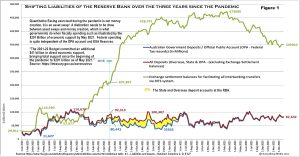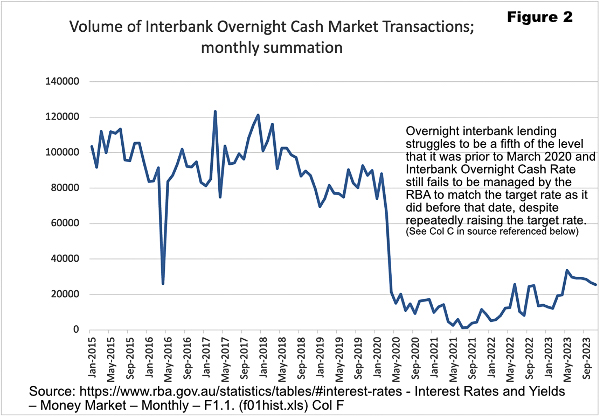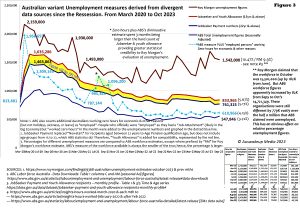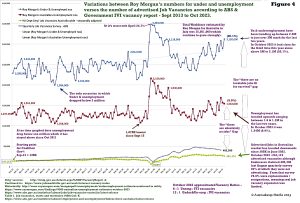Too much Interest, as Size Matters

By John Haly
The burden of supplying job vacancies falls on the government and business sectors. Instead, the government and media typically blame the unemployed, portraying them as unmotivated, parasitic welfare recipients. This is despite, by any unemployment measurement, there are more unemployed than open job positions.
This suggests that the real issue is a lack of jobs in the public and private sectors, and the market – not the unemployed – is to blame. If the RBA utilised more accurate unemployment estimates to evaluate unemployment instead of the ABS subset, it would never have a reason for hiking interest rates.
The ABS subset of unemployment data shows that the neoclassical assertion that unemployment is too low (and must be used to offset inflation) is pure propaganda. The ABS data fails to account for the larger share of domestic unemployment.

Exchange Settlement & OPA A/cs
This has not stopped the RBA from inflating your interest bills to benefit bankers’ profits which appears to be their only “success,” although they would not boast of it. None of the RBA’s publicly-recognised strategic goals appear to be progressing well. They have not regained management control of interest rates since March 2020. Interbank loans are a fifth of what they once were, with much of it sitting on deposit with the Reserve Bank and a consequential interest being paid less than interest received. Inflation has responded to supply changes, not the strategy of interest rate rises. All of this is despite attempts to boost lending by increasing banks’ Exchange Settlement Reserves during the pandemic (see Figure 1), which didn’t work either. Consequently, substantial overnight loans at these inflated interest rates are rarer (see Figure 2).

InterBank Market transactions
Governments, businesses, and central banks all make political decisions regarding unemployment. The corporate capital class employs it as a tool for pressuring working-class compliance with exploitation. The Reserve Bank of Australia (RBA) believes that the Non-Accelerating Inflation Rate of Unemployment (NAIRU) must be offset against inflation. The desired unemployment rate has been a highly flexible and shifting target percentage rate for decades. Even though post-World War II Western nations, including Australia, have had 2% to 3% unemployment for decades without significant inflation. Still, this zombie economic notion refuses to die. Remember that 2% unemployment occurred when gig jobs were virtually nonexistent?
Our current RBA governor believes that “full employment” is at 4.5% unemployment, and that our current rate of 3.7% is dangerously low. According to the ABS, the rate is 3.7% (Oct 23). Even though the Jobseeker and Youth Allowance count each month has been somewhere between 1.6 and 1.9 times that, over the last three years. That doesn’t even consider the harsh consequences of excluding Jobseekers from aid. For example, 502,698 jobseeker payments were suspended between July and September of this year. This averages more than 160,000 per month. Keep in mind that, according to ABS, the number of unemployed has been stable at roughly half a million for the last two years (see Figure 3). So, keep reading if that makes you suspicious that something isn’t quite kosher.

Multiple measures of unemployment
The ABS’s reported unemployment rate of 3.7% does not accurately reflect the domestic reality of unemployment as it affects the real numbers of people who are jobless. The media, capitalists, and political elite rarely, if ever, discuss what purpose the ABS statistics genuinely serve. It serves two fundamental functions:
- comparative analysis on an international scale and
- the interests of capitalist class exploitation.
The ABS approach to assessing employment by ILO methodology has been criticised as “imperfectly realised” (Pg 78-85). It does not consider internal or domestic unemployment in a country, a lack of employment opportunities, or decent welfare compensation. I have addressed the international comparative function before, so I will shift to the second aspect. The ABS’s primary domestic purpose is to gauge the unhindered accessibility of labour to employers, and as such, it is not a complete set.
Despite Treasurer Dr Jim Chalmers’ declared goal of attaining full employment, the September 2022 Job Summit failed to progress this. Instead, Chalmers advocated increasing the Permanent Migration Programme planning level to 195,000 for the fiscal year 2022-23. This is expected to relieve some skill shortages. Free higher education is still in place in many less economically advantaged European countries. Opponents believe that free tertiary education is financially unfeasible. However, free education has to become a higher political priority for spending.
Jim Chalmers recommended providing funds for the free provision of TAFE courses in 180,000 spaces in 2023. This barely registers as an impact on the ABS unemployment estimate of 473,000. Keep in mind that the ABS estimate is far lower than the counted number of people granted “JobSeeker” benefits. The Labor Party’s attitude lacks sincerity. The boost in immigration coincides with the interests of their corporate capitalist funders, who gain from cheap immigrant labour. The ABS approach benefits employers rather than the general public or government policy. Individuals who may not be immediately available, even if they have had NO work and NO pay in a month, but have a “job attachment” in the gig economy, are in family businesses, or are busking on the streets. Foreign workers who have been here less than four years, those registered in government-sponsored jobless work programmes, and those who are unable to provide active evidence of seeking employment are excluded. This alone disqualifies thousands of people from being considered unemployed. The ABS description does not give the public an accurate picture of Australian domestic unemployment. Including unpaid persons with gig job affiliations would significantly increase unemployment, approaching the Reserve Bank’s NAIRU threshold of 4.5%, effectively demolishing the rationale for interest rate hikes. (see Figure 3)
The Australian Reserve Bank’s (RBA) monetary policy framework does not use a precise unemployment count (rather than an estimate) like Jobseeker’s account. Doing so would imply an unemployment rate higher than 5.6%, negating any justification for raising interest rates. The opportunity to have the country with one of the world’s highest household private debt to GDP ratios (112% in 2023) shift money from the debtors to wealthy financiers and banks would be wasted. It is strange that, in a neoliberal society that worships markets and the private sector, the government and media are refusing to accept Roy Morgan’s estimate of unemployment, which was at 1.5 million in October and has stayed continuously high over the past two years. The conservative establishment’s stance remains mostly anti-private-sector research in areas that do not agree with the Reserve Bank’s objective. The government and media frequently cite underemployment. However, Roy Morgan’s “disreputable” private enterprise model for unemployment has maintained these ABS subset numbers at levels that are roughly half to one-third lower.
I chose October 2023 statistics because they were all available when I started writing this paper. Over the last year, the Australian Bureau of Statistics (ABS) has consistently recorded unemployment at around half a million (currently 2/3rds of the JobSeeker count and 1/3rd of the Roy Morgan estimate). Even the seasonally adjusted labour force increase claim varies greatly, which any statistician will recognise affects the percentage estimate for unemployment.
The difference between the September and October workforce measurements is 780K, more than the number of unemployed ABS claims. If that difference worries you, consider that Roy Morgan’s aggregate estimates of under and unemployment were at least twice as high as ABS’s (1.44 million), totaling 3.12 million. That corresponds to 20.1% according to Roy Morgan’s workforce numbers (15.5 million), but 21.19% if ABS’s estimate of 14.7 million is accurate. Although this is a fascinating statistical game, the fact that neither the private sector nor the government will step forward to provide relief, has an impact on people’s livelihoods.

RM Under and Unemployment & Job Vacancies (ABS & Dept Emp’)
The gap between the needs of the under and unemployed and the available job vacancies in the market is so large as to be insurmountable (see Figure 4). Both measurements of job vacancies posted and claimed via surveys conducted, respectively, by the Department of Employment and the ABS, plainly reveal the dismal provision of work by both the commercial and public sectors. I have already explored this and will do so again in a subsequent article. It demonstrates that governments have done little to improve the plight of the unemployed in the last half-century compared to the prior quarter century.
Finally, the graph in Figure 3 reveals that Roy Morgan’s estimates are the most probabilistically feasible. The ABS unemployment estimates and zero-hours figures outperformed the JobSeeker numbers from August to October 2021. Recognising JobSeeker or Roy Morgan’s prominent unemployment figures would indicate that the Reserve Bank’s interest rates should always have remained at the 0.1% level. Every step made by the RBA to raise interest rates is subsequently boosting inflation and living costs despite their intended goals, and is based on the presumption of low unemployment. Every claimed goal for their strategies is based on a total economic fabrication.
This article was originally published on AUSTRALIA AWAKEN – IGNITE YOUR TORCHES and Independent Australia.
Like what we do at The AIMN?
You’ll like it even more knowing that your donation will help us to keep up the good fight.
Chuck in a few bucks and see just how far it goes!
Your contribution to help with the running costs of this site will be gratefully accepted.
You can donate through PayPal or credit card via the button below, or donate via bank transfer: BSB: 062500; A/c no: 10495969










8 comments
Login here Register here-
uncletimrob -
New England Cocky -
Clakka -
New England Cocky -
andyfiftysix -
-
-
Return to home pageOf course, an alternative view is that un employment can be blamed on wages being too high.
“Get rid of unions = lower wages = we’ll employ more people” ….. I can just hear it those boardrooms.
Just like the gig economy was supposed to ease/solve unemployment.
Uhm … thank you for a concise explanation of the unfortunate financial policies currently being followed by the Albanese LABOR government.
.
My mate Blind Freddie reckons that he can see the only light at the end of this profitable bankers black hole is that some young smart office person in the RBA will suggest that the Governor has no idea, thus creating an excellent reason to slash the Stage 3 tax cuts for wealthy persons before ”the economy” rushes into a major depression caused by the beneficiaries spending their newly acquired government vote buying largesse.
.
Alternatively, the RBA may suddenly discover that when common wealth is evenly spread among the population the economy actually works for the benefit of that population.
Thanks John Haley,
Had to go to the article in Independent Australia to find John’s bio.
I guess most thinking folk understand the fundamentals of the statistical rort and beguilement being undertaken by successive governments for years, in a collaboration with banks, investors, employer organizations and medium to large businesses. It’s interesting to see it set out as has been done in this article.
That it’s been going on for about 50 years is no surprise. I well remember the dismal state of the economy and opportunity in Victoria, when Dick Hamer sold a site, a port and electricity to Alcoa for a song, to get money in the pockets of ordinary folk. And since, I understand that aluminium smelters are easy come, easy go, fundamentally on the basis of electricity cost. WA a gonner, Portland looking grim.
Progressively, since around that time, the black art of economic sophistry has moved from a yabber yabber (sufficient manumission) to facilitate a vote, through selling almost all public assets for a song, to a desperate contrivance to leverage investment from the asset accumulators, with the enfeebled ordinary folk becoming mere collateral damage.
A 50 year framework of bullshit. Governments have been conned and have conned themselves that they have no power that’s not for sale. The framework of bullshit has become so entangled in the machinations of all the key players that discombobulation is now written into the rules of all those seeking to maintain their sinecures. And from their ghost-town palaces, the asset accumulators are up shit creek because of strangulation of both demand and supply (genius), disemboweled state treasuries and lack of project opportunities. Collectively, they’ve run out of ideas for ‘healthy’ lies to dig themselves out of the reality of collapse that they’ve generated. Their collaborative spin has brought the essential spin of economies to a virtual standstill.
It seems they have resorted to a war (of hushed beguilement), the collaborators:
politicians
economists
treasuries
central banks
trading banks
investment banks
accountants
taxation lawyers
commercial enterprises
job placement consultancies
defense apparatus
philanthropists
religion industry
advertisers and
mainstream media
Whether it’s fire or flood, biblically, ballistically or atmospherically,
they’ve all demonstrated their magnificence in dragging the whole caboodle up shit creek.
As a testament to hubris, whether in the darkest recesses of their minds or in the limelight, these parasitic peddlers of bling and recipients of largesse seem only to know how to say “cheese” whether it stinks or not.
@ Ah Clakka, you have summed it up admirably.!!
I have been saying for years, speaking to walls, lol.
Economists are reactionary turds with no idea of where it’s all going.
With all the computing brain power available, they still can’t see the wood from the trees.
Or maybe, they wilfully don’t want to see.
All the ” free market” wishes have been enabled yet we are still going over the cliff. Yet the free market people want more.
Their only lever is inflation. Yes, that’s their lever. How else do you explain the down ward spiral? A few years of relative stability is always followed by rampant inflation. It’s used to keep us under an illusory control. As our illusory wealth is plundered once again. Got to work a bit harder this year Johnny…….
In an economy that functions with purpose, banks would be oiling the wheels NOT be the fucking wheels.
We have little by little created something we call an economy that does some weird shit to its people.
Pingback: Sorry, No Vacancy - Australia Awaken - ignite your torches
Pingback: Positing Job Guarantee Antecedents - Australia Awaken - ignite your torches
Pingback: Positing Job Guarantee Antecedents – Part 2 of 2 – WEA Pedagogy Blog